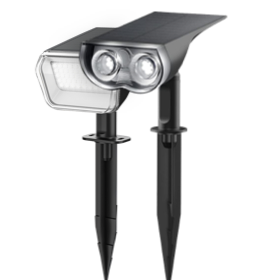Solar Light Batteries: The Ultimate Guide to Peak Performance & Premium Pairing
In This Article:
- Why Solar Light Batteries Matter
- Types of Rechargeable Batteries for Solar Lights
- How to Choose the Best Solar Light Batteries
- Top 5 Solar Light Battery Brands
- Elevate Your Solar Lighting with Linkind Smart Innovations
- Extending Battery Life: 7 Expert Tips
- FAQs
Solar light batteries - specifically advanced rechargeable batteries – act as the circulatory system of any solar-powered setup. These energy reservoirs determine if your high-efficiency solar lights maintain their brilliance through a winter night or dim prematurely at dusk. Modern systems leverage solar and LED synergy to push boundaries: think minimalist modern solar lights that double as art installations, or rugged outdoor solar lights that work in winter while buried under snow.
Yet even the smartest photovoltaic panels falter without a battery engineered for their rhythm. When your pathway lights flicker or security beams weaken, the culprit often lies in mismatched components – a high-efficiency solar light shackled to an undersized battery, or premium cells wasted on obsolete panels. This guide cuts through the confusion: discover how to diagnose charging flaws, select cold-tolerant rechargeable batteries that sync with your climate, and craft systems where every photon captured translates to hours of intentional illumination.

Why Solar Light Batteries Matter
While solar panels and LED fixtures steal the spotlight, rechargeable batteries quietly orchestrate the entire performance of your outdoor lighting system. These energy reservoirs act as the bridge between daytime solar harvesting and nighttime illumination, determining whether your setup delivers reliable brightness or frustrating flickers. Three critical factors separate mediocre systems from high-efficiency solar lights that thrive year-round:
Capacity (mAh): The Runtime Architect
Measured in milliampere-hours (mAh), capacity dictates how long your lights stay illuminated after sunset. A 2000mAh battery in a pathway light might provide 8 hours of runtime in summer, but that same cell could struggle to deliver 5 hours during winter’s shorter days. High-capacity batteries (3000mAh+) aren’t just about longevity—they compensate for cloudy days by storing surplus energy, ensuring consistent performance even when sunlight is sporadic. For outdoor solar lights that work in winter, prioritize batteries with at least 20% extra capacity to counter shorter charging windows.
Weather Resistance: The Silent Survivalist
From desert heatwaves to subzero blizzards, batteries endure what your solar lights’ housing often shields them from. Standard NiMH cells lose up to 30% efficiency below freezing, while premium lithium iron phosphate (LiFePO4) batteries retain 95% capacity at -20°C. This thermal stability isn’t just about cold climates—heat accelerates chemical degradation, making UV-resistant casing and pressure-regulated designs non-negotiable for coastal or tropical installations.
Compatibility: The Hidden Handshake
Not all batteries speak the same language as your solar light’s charge controller. A mismatched 3.7V lithium-ion cell can overstress a system designed for 3.2V LiFePO4 chemistry, causing premature charge circuit failure. Modern systems like bright solar landscape lights often require proprietary battery profiles—think Tesla’s Powerwall in miniature. Always cross-reference your light’s voltage requirements, physical battery tray dimensions, and charge/discharge cycles before upgrading.
Types of Rechargeable Batteries for Solar Lights
Choosing the right rechargeable battery is critical to maximizing the efficiency, lifespan, and reliability of your solar lighting system. Different battery types offer unique advantages depending on climate, usage patterns, and budget. Below, we break down the three most common rechargeable batteries for solar lights—NiMH, LiFePO4, and Lithium-Ion—to help you make an informed decision.
NiMH (Nickel-Metal Hydride)
NiMH batteries strike a balance between affordability and environmental friendliness, making them a practical choice for everyday solar lighting needs. While they may not outperform lithium-based options in extreme conditions, their reliability in moderate climates and lower upfront cost keep them relevant.
Key Features:
- Affordable and eco-friendly:Lower cost and less toxic than many alternatives.
- Suitable for moderate climates:Performs well in stable, non-extreme temperatures.
- Typical lifespan:2–3 years with proper maintenance.
LiFePO4 (Lithium Iron Phosphate)
LiFePO4 batteries are the gold standard for solar lighting systems requiring durability and high performance. Their exceptional cycle life and resilience in harsh conditions make them ideal for solar landscape lights and off-grid setups.
Key Features:
- High energy density & long cycle life:Withstands 2,000+ charge cycles for years of service.
- Ideal for extreme temperatures:Operates reliably in both scorching heat and freezing cold.
- Popular in solar landscape lights:Combines longevity with low maintenance.
Lithium-Ion (Li-ion)
Lithium-Ion batteries are prized for their lightweight design and high efficiency, though they require careful consideration in hot environments. Their compact size and rapid charging make them a favorite for portable solar lights.
Key Features:
- Lightweight and efficient:Compact energy storage with minimal weight.
- Less durable in high heat:Performance degrades faster in extreme temperatures.
- Versatile applications:Commonly used in smaller, portable solar lighting systems.
How to Choose the Best Solar Light Batteries
Selecting the right battery for your solar lights ensures optimal performance, longevity, and value. Beyond just matching technical specifications, factors like durability, brand reliability, and environmental adaptability play crucial roles. Below, we outline three essential criteria to guide your decision, followed by a comparative overview of popular battery types.
Voltage & Capacity
For modern solar lights with advanced features like app control, ensure voltage matches. Such as pathway lights, often use 3.2V batteries, while larger systems like security lights may require 12V. Capacity determines runtime—higher mAh means longer illumination but may require a larger solar panel for efficient charging. For example, a 2,000mAh battery balances size and performance for most residential setups.
Brand Reputation
Trusted brands prioritize quality, safety, and customer support. Companies like Tenergy and POWEROWL are renowned for their durable, high-performance batteries backed by warranties. Cheap, no-name alternatives may save upfront costs but often lack temperature protection, consistent output, or cycle longevity. Investing in reputable brands minimizes risks of premature failure or safety hazards.
Weatherproofing
Solar batteries face rain, heat, and freezing temperatures, so weather resistance is non-negotiable. Look for batteries rated for outdoor use, with features like corrosion-resistant casings or temperature tolerance ranges (e.g., -20°C to 60°C). Sealed designs prevent moisture damage, while lithium-based options like LiFePO4 inherently handle extreme climates better than NiMH.
Comparing Solar Light Battery Options
To simplify your choice, here’s a quick-reference table highlighting key specs and ideal applications for the three most common rechargeable battery types:
|
Battery Type |
Capacity (mAh) |
Lifespan |
Best For |
|
LiFePO4 |
1,000–3,000 |
5+ years |
Solar landscape lights |
|
NiMH |
600–2,800 |
2–3 years |
Garden lights |
|
Li-ion |
1,000–3,500 |
3–4 years |
Decorative fixtures |
By prioritizing voltage compatibility, brand reliability, and weatherproofing, you’ll ensure your solar lighting system delivers consistent, long-lasting performance in any season. Pair these insights with the table above to find the perfect battery for your needs.
Top 5 Solar Light Battery Brands
Selecting a reputable brand ensures your solar lights stay bright and reliable season after season. The best brands combine high capacity, durability, and weather resistance while catering to specific needs like affordability, portability, or extreme climate performance. Below are five top-rated solar light battery brands, each excelling in different applications:
POWEROWL 2800mAh NiMH:
POWEROWL’s 2800mAh NiMH batteries combine high capacity with eco-friendly performance, backed by a robust 3-year warranty. Their ability to hold a charge in moderate temperatures and resist over-discharge makes them ideal for solar yard lights, pathway markers, and other medium-duty outdoor setups.

Tenergy LiFePO4:
Tenergy’s lithium iron phosphate batteries strike a balance between budget-friendliness and endurance, offering over 1,000 charge cycles. Built to withstand harsh weather, they’re ideal for outdoor solar lights requiring long-term reliability.

Brightown 1300mAh:
Brightown specializes in compact, reliable batteries tailored for garden lights. With a 1300mAh capacity, they provide sufficient runtime for decorative or low-drain fixtures without overwhelming smaller solar panels.

EBL 1100mAh:
EBL’s 1100mAh batteries feature a sleek, portable design, often sold with a convenient charging case. Their lightweight build and efficient energy storage suit users prioritizing ease of use and quick replacements.

KINSUN 900mAh:
KINSUN offers an ultra-affordable option for low-drain solar fixtures like pathway markers or accent lights. While modest in capacity (900mAh), their durability and value make them a practical choice for basic setups.

Whether you prioritize longevity, capacity, or cost-effectiveness, these brands cover a spectrum of solar lighting needs. Pair your selection with the right battery type (NiMH, LiFePO4, or Li-ion) to maximize your system’s performance and lifespan.
Elevate Your Solar Lighting with Linkind Smart Innovations
Transform your outdoor spaces into energy-efficient wonderlands with Linkind solar lighting solutions—designed to harmonize with the principles of peak battery performance and intelligent design we’ve outlined. These aren’t just lights; they’re ecosystems of efficiency, durability, and creativity.
Linkind Smart Solar Spotlight SL5C: The Genius of Adaptive Illumination
Imagine solar lights that not only survive harsh climates but thrive in them. The SL5C pairs LiFePO4-grade resilience with smart tech, delivering 14+ hours of runtime even in sub-zero winters. Its MPPT-enhanced charging captures 23.5% more solar energy—perfect for climates where every photon counts.
Why It Shines:
- Sync with Nature & Rhythm: Program color-changing light shows (16 million hues!) via voice commands or app, aligning with music or moods.
- Survivalist Build: IP67 waterproofing and automotive-grade batteries laugh at rain, snow, and heatwaves.
- Zone Mastery: Group 32 lights into 8 zones—ideal for highlighting garden paths and securing dark corners without overloading your system.

-
Enhanced Solar Efficiency: Experience 24/7 illumination with these smart solar spotlights featuring MPPT technology that improves charging by 23.5%. Premium 5C automotive-grade technology delivers up to 14 hours of continuous solar powered spotlight performance.
-
App & Voice Control: Manage your solar landscape spotlights through the AiDot app or use voice commands with Amazon Alexa and Google Home via Linkind's Bluetooth Mesh Hub for convenient control of your solar outdoor spotlight network.
-
Dynamic Color Effects:Transform your yard with color changing solar spotlights offering 16 million color options. Create stunning light shows that sync with music—perfect for enhancing your landscape with solar spotlights for yard decoration.
-
Intelligent Scheduling: Program your solar colored spotlights with smart timers including dusk-to-dawn automation and customized schedules. Set your preferred brightness levels and timing to maximize your solar landscape spotlights' effectiveness.
-
Versatile Installation: Mount these IP67 waterproof solar outdoor spotlights on walls or ground with 360° horizontal and 180° vertical adjustability. Group up to 32 lights into 8 separate zones for comprehensive yard illumination.
Linkind Smart Solar Spotlight SL5: The Pioneer of Group Intelligence
Meet the world’s first solar spotlight with wireless group control, redefining how you manage outdoor lighting. The SL5 turns your yard into a choreographed canvas of light, blending security and artistry effortlessly.
Why It Stands Out:
- Command Your Landscape: Control unlimited lights via the AiDot app—dim, color-shift, or schedule entire zones (patio, driveway, garden) in seconds.
- Sound & Light Symphony: Sync its 16 million colorsto your playlist’s beat, transforming barbecues into immersive parties.
- Three Modes, Zero Effort: Choose Motionfor security, Luminance for dusk-to-dawn elegance, or Continuous for unwavering brilliance—all while conserving energy.

-
Group Control: The world's first solar spotlight with wireless capabilities to offer smart group control functionality.
-
Multiple Convenient App Functions: Control smart spotlights with the AiDot App. Adjust color, temperature, brightness, and use group control, music sync, and energy-saving features.
-
Music Sync & Preset Scenes: Sync RGBTW smart solar lights with music by granting microphone permission. Customize effects, preset scenes, or choose from 16 million colors to enhance your outdoor ambiance.
-
Three Optional Lighting Modes: Linkind solar lights feature 3 modes: Motion for safety and efficiency, Luminance for automatic dusk-to-dawn lighting, and Continuous for constant illumination.
-
Enhanced Lighting & Easy Installation: Linkind solar spotlights are adaptable for ground or wall mounting, with 360° horizontal and 180° vertical adjustability.
Linkind StarRay Solar Spotlight: Where Precision Meets Power
For those who demand both artistry and reliability, the StarRay boasts a 48% larger solar panel with PET-laminated monocrystalline tech. It’s the overachiever of solar charging, converting 30% of sunlight into energy—ideal for cloudy regions or shaded yards.
Why It Stands Out:
- Sun Chaser Design: 180° horizontal + 90° vertical adjustability ensures panels soak up light even in tricky angles.
- Cold Warrior: Functions flawlessly at -20°C, making winter storage obsolete.
- Instant Ambiance: No wiring, no fuss—install in minutes and cycle through vibrant colors or crisp whites for year-round versatility.

-
Bright Lights with Vibrant Colors : The vibrant multicolored lights can be used in fixed color mode or color cycling mode, allowing you to achieve the perfect effect for any occasion.
-
Maximum Convenience with Unmatched Flexibility : StarRay isn’t limited to just vertical adjustments, the innovative design allows 90° of vertical and 180° of horizontal flexibility for optimizing sun exposure and precise lighting.
-
Stays Powered with Advanced Solar Charging : Features a solar panel 48% larger than that of similar products utilizing industry-leading PET laminated monocrystalline silicon construction. It boasts an energy conversion rate of up to 30%—far exceeding traditional panels.
-
Reliable and Easy to Install: Designed for hassle-free installation, Linkind StarRay Solar Spotlight does not require complicated wiring or a meticulous setup. Whether installing in the the ground or mounting on a wall, the whole process takes mere moments.
Linkind SP004 Color-Changing Solar Spotlights: The Entertainer’s Dream
Hosting a Halloween bash or a serene garden dinner? The SP004’s 10-color modes (including pumpkin-orange and icy blue) adapt to any theme, while its 50-LED array bathes your yard in a 110° glow—minus the glare.
Why It Dazzles:
- Seasonal Intelligence: Toggle between Efficiency (summer) and Power-Saving (winter) modes with a button press.
- Battery Beast: A 1,500mAh Li-Po cell paired with cold-resistant materials ensures performance from -20°C to 45°C.
- Glow Guardian: Frosted shells diffuse light evenly, preventing hotspots while protecting against UV degradation.

-
Enhanced Multicolor Design: Feature a versatile color-changing system with pumpkin-orange for Halloween and 6500K cool white. Switch between 10 color modes, including Red, Green, and Blue.
-
50 LEDs Outdoor Lights: Linkind’s latest solar outdoor lights include 50 ultra-bright LEDs, a wide 110° lighting angle, and an anti-glare frosted shell for uniform garden illumination.
-
Ultra-Long Runtime and Solar Charging: Offers solar charging with up to 30% energy conversion efficiency, ideal for saving on electricity bills.
-
Efficiency and Power-Saving Modes: Easily switch between Efficiency mode for summer and Power-Saving mode for winter by long-pressing the power button with Linkind outdoor solar lights.
-
Cold Resistant and Waterproof: Made from high-quality ABS and PC materials, Linkind solar lights are cold resistant (-20°C to 45°C), and IP67 waterproof, ensuring durability in all weather conditions.
Why Linkind Belongs in Your Solar Arsenal
Linkind solar solutions embody the trifecta we champion: battery longevity, climate adaptability, and smart energy management. Whether you’re upgrading garden lights or building a security network, these products eliminate guesswork with:
- MPPT & LiFePO4 Synergy: Maximize charging efficiency and battery lifespan.
- App-Driven Control: Fine-tune settings to prevent over-discharge and optimize cycles.
- Future-Proof Durability: IP67 ratings and temp-resistant builds align with our winter storage and weatherproofing tips.
Pair these innovations with the battery wisdom from our guide, and your solar setup won’t just light up the night—it’ll redefine it.
Extending Battery Life: 7 Expert Tips
Maximizing the lifespan of your solar light batteries not only saves money but also ensures consistent, reliable performance year-round. Environmental factors, maintenance habits, and battery technology all play a role in longevity. Follow these seven expert-backed strategies to keep your solar lighting system running efficiently through seasons and weather extremes.
Clean Solar Panels Monthly
Dust, pollen, and debris on solar panels can block sunlight, reducing charging efficiency by up to 30%. Wipe panels gently with a damp cloth every month—especially in dry or dusty regions—to ensure maximum energy absorption. For stubborn grime, use a mild soap solution, but avoid abrasive materials that could scratch the surface.
Avoid Over-Discharge
Repeatedly draining batteries to 0% accelerates wear. Opt for batteries with built-in protection circuits (common in LiFePO4 and premium Li-ion models) that automatically disconnect when voltage drops too low. For systems without this feature, consider adding a low voltage disconnect module.
Winter Storage
In sub-freezing climates, remove batteries from solar lights during winter. Cold temperatures can permanently damage NiMH and Li-ion cells, reducing capacity. Store them in a dry, room-temperature environment, and recharge every 2–3 months to prevent deep discharge.
Partial Shading
Even minor shading can cripple a solar panel’s output. Position lights where panels receive 6–8 hours of direct sunlight daily, away from trees, roofs, or walls. Trim foliage seasonally and angle panels southward (in the Northern Hemisphere) for optimal exposure.
Upgrade to LiFePO4
Lithium iron phosphate (LiFePO4) batteries outperform NiMH and standard Li-ion in lifespan and temperature resilience. They withstand 2,000+ cycles and operate smoothly in -20°C to 60°C ranges, making them ideal for outdoor solar lights that work in winter. Though pricier upfront, their durability offsets long-term replacement costs.
Opt for Smart Solar Lights
Choose solar lights with built-in sensors that optimize charging and discharging cycles. Features like adaptive brightness control, automatic on/off modes, and overcharge protection help reduce unnecessary battery strain and extend lifespan.
Regular Maintenance
Inspect battery terminals and wiring every 3 months for corrosion or loose connections. Clean terminals with a vinegar-water mix or baking soda paste and tighten any frayed wires. For sealed units, check for cracks or moisture ingress.
Conclusion
The right rechargeable battery transforms solar lights from fleeting novelties into resilient, year-round assets. By aligning battery type (NiMH, LiFePO4, or Li-ion) with your climate, usage, and light specifications, you unlock extended runtime, weather resilience, and cost savings. Prioritize reputable brands, voltage compatibility, and proactive maintenance—like panel cleaning and winter storage—to maximize lifespan. Whether illuminating garden paths or securing landscapes, informed choices ensure every sunset fuel a brighter, more reliable dawn. Invest wisely, maintain diligently, and let your solar lights shine at their peak for years to come.
FAQs
Q: What type of rechargeable battery is best for solar lights?
A: NiMH: Affordable/eco-friendly. LiFePO4: Longer lifespan/extreme temps. Avoid alkaline.
Q: How often should I replace solar light batteries?
A: NiMH: 2–3 years. LiFePO4: 5+ years. Replace if dimming, short runtime, or no charge.
Q: Can I use regular AA batteries in solar lights?
A: No. Use rechargeable batteries only. Alkaline can’t recharge and may damage lights.
Q: How do I maintain solar light batteries in winter?
A: Remove/store indoors in freezing temps. Keep panels clean.
Q: Does a higher mAh rating mean longer-lasting solar lights?
A: Yes, higher mAh = longer runtime. Ensure voltage matches lights.






































